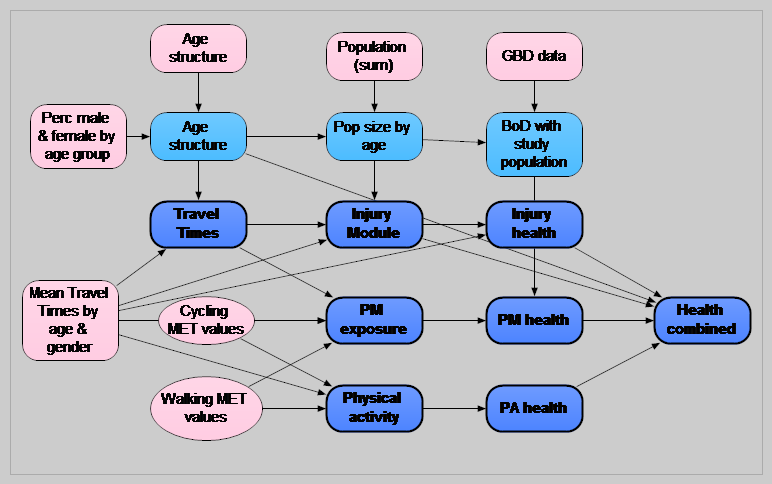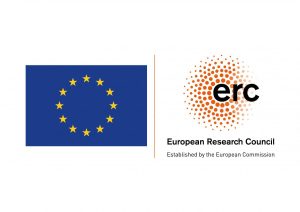Integrated Transport and Health Impact Modelling Tool (ITHIM)
ITHIM refers to a range of related models and tools developed at CEDAR to perform integrated assessment of the health effects of transport scenarios and policies at the urban and national level. The health effects of transport policies are modelled through the changes in physical activity, road traffic injury risk, and exposure to fine particulate matter (PM2.5) air pollution. Some versions of ITHIM also predict changes in CO2 emissions. ITHIM is being used in research and by health and transport professionals to estimate the health impacts of scenarios, compare the impact of travel patterns in different places, and model the impact of interventions. ITHIM works either as a stand-alone model, or it can be linked with other models (e.g. transport, health, economic).
Figure 1: The general overview of the ITHIM model. Picture is from ITHIM version 2 (see version description below). Arrows show the flow of data inside the mode. (PM = fine particulate matter air pollution, GBD = Global Burden of Disease study).

ITHIM models exposure to physical activity by comparing distributions of weekly physical activity under different scenarios. Walking, cycling and other types of physical activity are combined as MET hours per week of activity. Outcomes affected by physical activity include various cardiovascular diseases, depression, dementia, diabetes, breast cancer, and colon cancer. ITHIM also models health changes through the all-cause mortality. A comparative risk assessment method is used to estimate how changes in population physical activity result in changes in health burden. In the most recent versions this is being replaced with a multistate life table model.
Road traffic injuries are modelled using a risk, distance and speed based model. Differences in risk by gender and age are also included. This approach allows ITHIM to look at how absolute numbers of injuries and injury risks could change for different transport modes as travel distances between modes changed.
Fine particulate matter (PM2.5) air pollution risks are calculated for the general population (background rates) as well as mode specific rates for different transport modes. The exposure changes for population are based on comparison of local generated PM2.5 emissions and concentrations in the study area. In ITHIM version 2 also the personal exposure to air pollution while walking and cycling is taken into account.
The health effects of ITHIM are presented as disability-adjusted life-years (DALY) and number of attributable deaths. Background burden data for study areas are estimated from Global Burden of Disease studies.
ITHIM versions
Below are listed the main ITHIM versions
- ITHIM Excel: First version of ITHIM was implemented as a spreadsheet model in Microsoft Excel. ITHIM Excel had all three pathways (physical activity, injuries and air pollution). Physical activity variation between people was modelled with simple point estimate approach. ITHIM has been used to model scenarios for the UK and the USA (Woodcock et al. 2009, 2013, Maizlish et al. 2013).
- ITHIM for California: ITHIM California was developed by Dr Neil Maizlish and is used to predict benefits of climate mitigation strategies of shifting commuter travel from personal passenger vehicles to walking and bicycling and/or to electric vehicles and biofuels (low carbon driving). Originally implemented in Excel, the current versin is in R and is available here.
- ITHIM Analytica: The second version of ITHIM was developed to take better into account uncertainties and variability in key input data in the calculation. ITHIM version 2 was implemented with Analytica software (http://en.wikipedia.org/wiki/Analytica_%28software%29) and the uncertainty & variability was modelled by using Monte Carlo simulation. Key publication is the London cycle hire paper published in 2014.
- ITHIM Global: ITHIM Global is designed to work with limited travel survey and traffic injury data. It is implemented in R and the code base is here. A first study using the model is available here .
- ITHIM England: ITHIM England is a spatial model, using an approach for settings with high quality data. The code base is hosted here. A parallel model is also being created for Melbourn
- Other versions of ITHIM have been developed by other reserach groups, usually building on ITHIM Excel.
We are moving towards making all our models open source.
ITHIM funding
- The developement of ITHIM was originally supported by CEDAR.

- ITHIM Analytica was supported by Dr Woodcock’s MRC Career Development Grant
- ITHIM Global was initially supported by the MRC Global Challenges TIGTHAT project, further developement is supported by the ERC project GLASST
- ITHIM England was initially supported by the MRC Methodology project, and further development is supported by the MRC / NHMRC project JIBE and by the ERC project GLASST.
GLASST has received funding from the European Research Council (ERC) under the Horizon 2020 research and innovation programme (grant agreement No 817754). This material reflects only the author’s views and the Commission is not liable for any use that may be made of the information contained therein.
ITHIM related projects
We are collaborating on many international research and policy collaborations involving ITHIM these include:
- USA: Nashville, Tennessee, Nashville Metropolitan Planning Organization
- USA: Portland, Oregon Department for Public Health
- Malaysia: Kula Lumpur, United Nations University – International Institute for Global Health
- Canada: Newfoundland University
- Brazil: Sao Paulo, University of Sao Paulo.
- USA: California, Center for Climate Change and Health, Public Health Institute
- India: Delhi and Visakhapatnam, Indian Institute of Technology, Delhi
ITHIM email list and ITHIM community
ITHIM is currently used by several researchers and authorities in number of cities, regions and countries (including USA, Canada, Malaysia, Brazil, India). ITHIM email list is the list in which developers of ITHIM will share the news from ITHIM community with other users and interested parties. We expect to send one email every 2-3 months.
Subscribe
Unsubscribe
If you would like to unsubscribe from future mailings, please fill in the form below.
Contact us
If you would like to use ITHIM in research or for policy development please email James Woodcock.
Publications
Woodcock J, Edwards P, Tonne C, Armstrong BG, Ashiru O, Banister D, et al. 2009. Health and Climate Change 2 Public health benefits of strategies to reduce greenhouse-gas emissions: urban land transport. Lancet 374:1930–1943.
Woodcock J, Givoni M, Morgan AS. 2013. Health impact modelling of active travel visions for England and Wales using an Integrated Transport and Health Impact Modelling Tool (ITHIM). PLoS One 8; doi:10.1371/journal.pone.0051462.
Maizlish N, Woodcock J, Co S, Ostro B, Fanai A, Fairley D. 2013 Health cobenefits and transportation-related reductions in greenhouse gas emissions in the San Francisco Bay area. American Journal of Public Health 103(4):703-9.
Woodcock J, Tainio M, Cheshire J, O’Brien O, Goodman A. 2014. Health effects of the London bicycle sharing system: health impact modelling study. BMJ 348:g425.
Gotschi T, Tainio M, Maizlish N, Schwanen T, Goodman A, Woodcock J. Contrasts in active transport behaviour across four countries: How do they translate into public health benefits? Prev Med
de Sá T, Tainio M, Goodman A, Edwards P, Haines A, Gouveia N, Monteiro C, Woodcock J. Health impact modelling of different travel patterns on physical activity, air pollution and road injuries for São Paulo, Brazil Environment International

 MRC Epidemiology Unit
MRC Epidemiology Unit